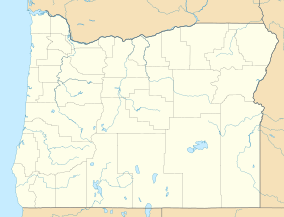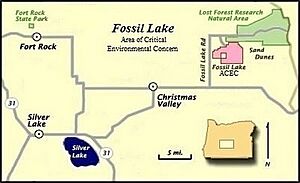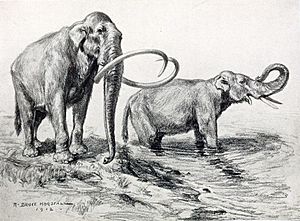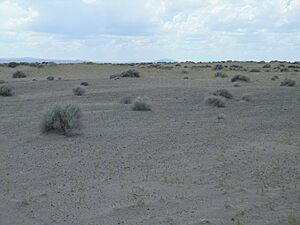Fossil Lake (Oregon) facts for kids
Quick facts for kids Fossil Lake |
|
|---|---|
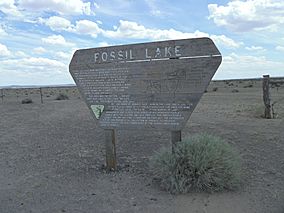
Fossil Lake interpretive sign
|
|
| Location | Lake County, Oregon, United States |
| Area | 10.2 sq mi (26 km2) |
| Elevation | 4,295 ft (1,309 m) |
| Governing body | Bureau of Land Management |
Fossil Lake is a dry lakebed in the remote high desert area of northern Lake County, Oregon. Long ago, during the Pleistocene epoch (which was a very cold time, often called the Ice Age), Fossil Lake was a huge, ancient lake. Many animals lived around this lake. Over time, their remains turned into fossils in the lake's mud and sand.
Because of these fossils, Fossil Lake has been a very important place for scientists to study for over 100 years. Paleontologists (scientists who study fossils) have found fossils of many different mammals, birds, and fish here. Some of these fossils are as old as 2 million years! The Bureau of Land Management protects this area, calling it the Fossil Lake Area of Critical Environmental Concern.
Contents
Where is Fossil Lake?
Fossil Lake is in a quiet, remote part of northern Lake County, Oregon. It is about 19 miles (31 km) by road from a small town called Christmas Valley. It's also about 65 miles (105 km) southeast of Bend and 79 miles (127 km) north of Lakeview if you measure in a straight line.
To get there from Christmas Valley, you drive east on County Road 5–14 for about 8 miles (13 km). Then, you turn north onto County Road 5-14D. After another 8 miles (13 km), you turn east onto a gravel road called County Road 5-14E. After about 1.7 miles (2.7 km) on that road, you turn south onto a rough dirt road that isn't marked. The sign for Fossil Lake is about 1.4 miles (2.3 km) down this dirt road.
You cannot drive vehicles into the Fossil Lake protected area. Visitors must walk the last 150 yards (140 m) to the sign. The actual dry lakebed of Fossil Lake is about 1 mile (1.6 km) southwest of the sign.
How Fossil Lake Formed
The ground under Fossil Lake is made of basalt rock, which came from ancient lava flows during the Pliocene and Pleistocene times. After a lot of faulting (when the Earth's crust cracks and moves), a large basin formed. This basin then filled with water during wet periods of the Ice Age, becoming a lake that was about 200 feet (61 m) deep.
Over the last 3,200 years, the water in this basin, including Fossil Lake, completely dried up. This left behind the dry, high-desert environment you see today. The lakebed itself is made of old lake sediments and other materials carried by water. You can also find pumice sand from volcanoes like Mount Mazama and Newberry Crater in the soil.
Underneath the topsoil, there's a hard layer of caliche (a type of hardened soil). This layer doesn't let water drain through it. This special layer helps trees like ponderosa pine survive in the nearby Lost Forest Research Natural Area, even though it's a desert.
In 1877, there were still two small ponds at the Fossil Lake site that would appear and disappear with the seasons. They were called the Fossil Lakes. Today, both ponds are completely dry, and the name "Fossil Lake" now refers to just the western dry-pond area. The lakebed is generally flat and sits about 4,295 feet (1,309 m) above sea level. To the east, there are large, moving Christmas Valley Sand Dunes. These dunes are made of sand blown from Fossil Lake, mixed with volcanic ash and pumice.
A Rich History of Discovery
The first settlers came to the Christmas Lake Valley around 1865. In June 1877, John Whiteaker, a former governor of Oregon, visited the Fossil Lake area. He found a large dry lakebed with two small salty ponds. Whiteaker named them the Fossil Lakes. He also found many exposed fossils, including those of elephants, camels, horses, and elk. He even found ancient human tools. Whiteaker estimated that the fossil beds were about 1 mile (1.6 km) wide and over 4 miles (6.4 km) long. After his trip, he gave his fossils to Thomas Condon, a famous paleontologist at the University of Oregon.
Later that year, Condon returned to Fossil Lake with Whiteaker's son to study the fossils more closely. Condon's discoveries made other famous paleontologists interested in the site.
Many paleontologists visited Fossil Lake in the late 1800s to collect fossils and do research. These included Edward Drinker Cope from the Academy of Natural Sciences of Drexel University, Othniel Charles Marsh from Yale University, and Charles Hazelius Sternberg, an amateur paleontologist. The Smithsonian Institution also started research there. In 1901, Annie Montague Alexander collected fossils for the University of California. During this time, local settlers said that fossils were often taken away by the wagon load.
After 1906, more people started to settle in the Christmas Valley basin. A post office opened near Fossil Lake. Settlers used the area for grazing sheep, cattle, and horses. But because of the harsh desert conditions, most settlers left their farms by 1920. A long drought in the 1920s and 1930s stopped dry farming in the area.
More fossil research happened in the early 1900s. In 1907, David Starr Jordan identified some fish fossils. In 1911, Loye Holmes Miller found and described new bird fossils. Scientists also studied how old the fossils were, realizing they were older than first thought.
In 1977, the Bureau of Land Management (BLM) temporarily banned vehicles from the Fossil Lake area to protect it. In 1979, this ban became permanent. In 1983, the BLM combined Fossil Lake, the nearby Lost Forest Research Natural Area, and the Christmas Valley Sand Dunes into one large Area of Critical Environmental Concern. It is now against the law to collect fossils in this area without a special permit from the BLM.
In the early 1990s, the BLM worked with the South Dakota School of Mines to find and study more fossils. This project lasted over ten years. The fossils found are now kept at the South Dakota School of Mines in Rapid City.
In 2017, a team from the University of Oregon, with help from the BLM, found a trail of Columbian mammoth footprints. The trail had 117 mammoth prints in a 66 feet (20 m) by 25 feet (7.6 m) area. Scientists believe these tracks were made about 43,000 years ago.
Amazing Fossil Discoveries
The fossil beds at Fossil Lake cover at least 10,000 acres (4,000 ha). Many expeditions have collected fossils here over the years. This site has more Holocene fossils (from the last 11,700 years) than almost any other place in the world, except for the La Brea Tar Pits in California.
Scientists have found fossils from:
- At least 23 different kinds of mammals.
- 74 different kinds of birds.
- 7 different kinds of fish.
- 11 different kinds of mollusks (like snails).
Some of the large mammal fossils found include:
- Columbian mammoths
- Ground sloths
- Dire wolves
- Giant beavers
- Pre-historic bison
- Three types of camels
- Several types of horses
- Peccary (a pig-like animal)
- An extinct bear
Bird fossils include flamingos, pelicans, swans, and large eagle species. Fish fossils include tui chub and several types of salmon. About two-thirds of the fossil species found at Fossil Lake are now extinct, meaning they no longer exist today.
The oldest fossils found at Fossil Lake are from the Pleistocene epoch and are up to 2 million years old. Some artifacts (tools or objects made by humans) found at Fossil Lake suggest that humans might have hunted in this area when some of these large mammals were still alive.
The Bureau of Land Management is concerned about protecting these fossils. The fossil beds go beyond the protected area, so there's a risk that vehicles or grazing animals could damage them. Also, people sometimes try to collect fossils illegally. Wind and sand also cause newly exposed fossils to break apart quickly. Because of this, scientists try to collect new fossils as soon as they are found.
Today, large collections of fossils from Fossil Lake are kept at the University of Oregon, the Smithsonian Institution, the South Dakota School of Mines, the University of California at Los Angeles, and the University of California at Berkeley.
Environment and Climate
Based on weather data, the average yearly temperature in the Fossil Lake area is about 43 °F (6 °C). The hottest and driest months are July and August, with an average temperature of 63 °F (17 °C). The coldest months are December and January, with average temperatures around 30 °F (−1 °C) and 28 °F (−2 °C).
Fossil Lake gets about 8.7 inches (22 cm) of rain each year. The wettest months are December and January, with a smaller wet period in May and June. However, the weather here can be very unpredictable. For example, there was a very bad drought (a long period with little rain) in the 1920s and early 1930s.
The plants around Fossil Lake are typical of a high desert. You'll see lots of big sagebrush, low sagebrush, and silver sagebrush. Other plants include green rabbitbrush, rubber rabbitbrush, and greasewood. There are also many types of grasses like Sandberg bluegrass and needle-and-thread grass. You might also find flowering plants like prickly-phlox and common wooly sunflower.
Wildlife
The animals living around Fossil Lake are common for the high desert in south-central Oregon.
Mammals
Larger mammals you might see include pronghorn (a fast deer-like animal), American badgers, and coyotes. Smaller animals include Black-tailed jackrabbits, Ord's kangaroo rats, and different types of mice. There are also 13 kinds of bats that live in the desert around Fossil Lake. In 1917, a very small bear was killed near Fossil Lake. People first thought it might be a new kind of "lava bear," but it turned out to be an unusually small American black bear that was stunted because it didn't get enough food.
Birds
Fossil Lake is home to many bird species. These include the greater sage-grouse, black-billed magpie, pinyon jay, Brewer's blackbird, American robin, mountain bluebird, sage thrasher, Sagebrush sparrow, and loggerhead shrike. You can also spot birds of prey like prairie falcons, red-tailed hawks, and golden eagles.
Reptiles
Several types of snakes and lizards live in the Fossil Lake area. Snakes include western rattlesnakes, gopher snakes, striped whipsnakes, and night snakes. Common lizards are sagebrush lizards, short-horned lizards, side-blotched lizards, western fence lizards, and western skinks.
- Shine, Gregory P. "Fossil Lake"..


